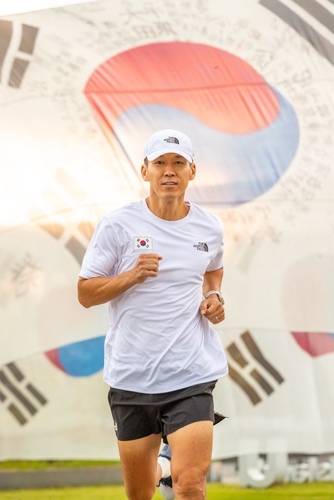Marking the Steps of Liberation
We reflect on the meaning of liberation.
On August 15, 2025 — Gwangbokjeol (Korea’s Liberation Day) — public ceremonies across Seoul and the country attracted broad attention.
Among them, the most visible was a charity marathon led by singer Sean called the “2025 815 Run.”
Sean ran 81.5 km and finished in 7 hours, 50 minutes, and 22 seconds, while participation reached a record 19,450 people.
This performance did more than demonstrate stamina.
The event raised about 2.38 billion won (roughly $1.8 million at current exchange rates), which organizers say was delivered to Korea Habitat (the Korean affiliate of Habitat for Humanity) to fund home repairs and improvements for descendants of Korea’s independence heroes (people officially recognized for efforts against Japanese colonial rule).
In that way, the run combined historical commemoration with a public-duty gesture.
Why is the event getting attention now?
The purpose is clear.
The 815 Run began in 2020 and is held each year on March 1 and August 15 to raise funds and awareness for independence-era families.
The 2025 edition, held on the 80th anniversary of Liberation Day, explicitly highlighted gratitude and support for those families and their descendants.
At the same time, Sean’s personal profile mattered.
He is a well-known singer (formerly part of the duo Jinusean) with a long record of public service, and that trust appears to have helped mobilize both citizens and corporate sponsors.
As a result, more people and organizations joined and contributed funds and manpower.
City marathon, threading history
The scene felt immediate and human.
The 81.5 km route traced more than a course; it read as a chain of public memory.
Many participants posted photos and video of Sean’s finish and their own participation on social media, and online reaction was largely favorable.
However, cautious voices emerged as well.
Some internet users and experts warned that large events led by celebrities can sometimes boost a star’s commercial image as much as they advance the public good.
Meanwhile, questions about the transparency of donations and whether the support will be sustained over time have continued to surface.

Listening to both sides
Supporters make a clear case.
Mourning and remembering on national holidays like Liberation Day while providing help to vulnerable groups carries civic value.
In concrete terms, the roughly 2.38 billion won raised for housing work is a direct, material form of assistance for the families involved.
Also, the charity-marathon model connects fitness and fundraising.
Large public participation helps normalize charitable giving and can spread a culture of philanthropy.
From this viewpoint, Sean and corporate sponsors played a constructive role.
On the other hand, critics raise persuasive points.
First, events led by celebrities naturally elevate that person’s brand, which can blur the boundary between public service and image management.
Second, transparency around how donations are spent matters.
Civic observers ask whether funds will produce long-term benefit for independence-heritage families and whether monitoring and public reporting are sufficient.
Korea Habitat and the event organizers will need regular reporting, audits, and beneficiary tracking to ease those concerns.
Benefits and concerns from another angle
There is another perspective to consider.
Collaboration among local communities, corporations, and individuals can be a sign of social solidarity.
The scale — nearly 19,450 participants and about 2.38 billion won raised — is exceptional for a single event.
On the other hand, safety should not be underestimated.
An 81.5 km course places heavy physical demands on many participants.
In hot weather, long-distance events increase the risk of injury or heat illness, so robust safety measures and medical support are essential.
Additionally, sustainability remains an open question.
Observers argue the effort must move beyond one-off drives and be tied to institutional support so that help continues year after year.
That step would mark a maturing of the country’s giving culture.
Comparisons are useful.
Historically, holiday-centered charity campaigns have been effective at reviving public memory.
However, fewer examples show a direct link from commemoration to durable welfare improvements.
Therefore, whether the 815 Run becomes more than a single spectacle depends on future implementation, public reporting, and policy links.
If Korea Habitat and the organizers publish regular, detailed outcomes and processes, they will strengthen public trust and increase the chances that this model leads to sustained change.
To conclude.
The 2025 815 Run successfully recalled the meaning of Liberation Day and generated substantial donations for housing improvements.
Yet the event also raises issues that need attention: the risk of commercialization around celebrity-led causes, the need for donation transparency, participant safety on a very long course, and the long-term sustainability of support.
Accordingly, organizers should disclose how donations are used and report the living-condition improvements of beneficiary households, while integrating clearer safety protocols and a plan for ongoing assistance in future events.
If they do so, the run could move from commemoration to a practice that changes social norms.
Key summary:
Singer Sean’s 2025 815 Run, held for the 80th anniversary of Korea’s Liberation Day, covered 81.5 km, drew 19,450 participants, and raised about 2.38 billion won to be handed to Korea Habitat for housing support for descendants of independence-era figures.
The event helped spread a giving culture but left unresolved questions about commercialization, donation transparency, participant safety, and long-term sustainability.
Regular public reporting and institutional links would make the social value more durable.
We leave the reader with this question: Do you believe commemorative events like this can drive lasting social change?